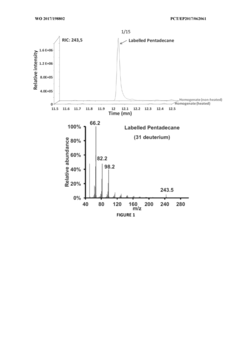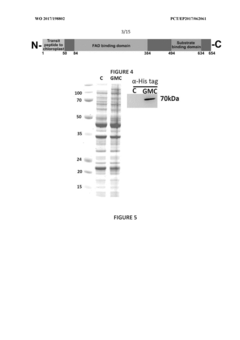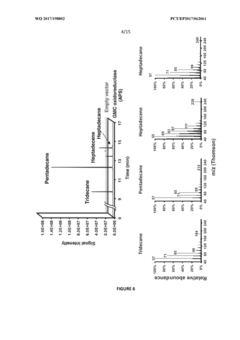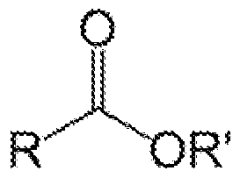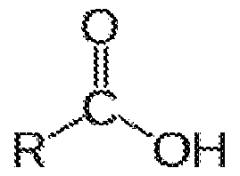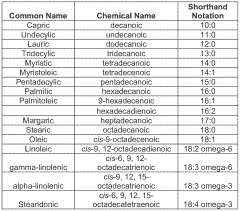Decane’s Contribution to Long-Chain Alkane Biodegradation Pathways
JUL 28, 202510 MIN READ
Generate Your Research Report Instantly with AI Agent
Patsnap Eureka helps you evaluate technical feasibility & market potential.
Decane Biodegradation Background and Objectives
Decane, a long-chain alkane with ten carbon atoms, plays a crucial role in understanding the biodegradation pathways of long-chain alkanes. The study of decane's biodegradation has been a focal point in environmental microbiology and biotechnology for several decades. This research area has gained significant importance due to the increasing concerns about environmental pollution caused by petroleum hydrocarbons and the need for effective bioremediation strategies.
The primary objective of investigating decane's contribution to long-chain alkane biodegradation pathways is to elucidate the mechanisms by which microorganisms break down these complex hydrocarbons. This knowledge is essential for developing more efficient bioremediation techniques and for understanding the natural processes of hydrocarbon degradation in various ecosystems.
Historically, the research on alkane biodegradation began in the mid-20th century, with early studies focusing on short-chain alkanes. As analytical techniques advanced, researchers expanded their focus to longer-chain alkanes, including decane. The 1970s and 1980s saw a surge in research on the microbial degradation of hydrocarbons, driven by the need to address oil spills and contaminated sites.
The evolution of this field has been marked by several key milestones. These include the identification of alkane-degrading microorganisms, the elucidation of enzymatic pathways involved in alkane oxidation, and the discovery of gene clusters responsible for alkane degradation. Decane, being a medium-length alkane, has served as a model compound for understanding the degradation of both shorter and longer chain alkanes.
Recent technological advancements, particularly in genomics, proteomics, and metabolomics, have revolutionized our understanding of decane biodegradation. These tools have allowed researchers to identify novel enzymes and metabolic pathways, as well as to study the regulation of genes involved in alkane degradation at a molecular level.
The current research goals in this field are multifaceted. They include identifying and characterizing new microbial strains capable of efficient decane degradation, unraveling the complex interactions within microbial communities during biodegradation processes, and developing strategies to enhance the rate and extent of decane biodegradation in various environmental conditions.
Furthermore, there is a growing interest in exploring the potential of decane-degrading microorganisms for industrial applications, such as the production of biosurfactants and biofuels. This shift towards biotechnological applications represents an exciting new direction in the field, promising innovative solutions for both environmental remediation and sustainable chemical production.
The primary objective of investigating decane's contribution to long-chain alkane biodegradation pathways is to elucidate the mechanisms by which microorganisms break down these complex hydrocarbons. This knowledge is essential for developing more efficient bioremediation techniques and for understanding the natural processes of hydrocarbon degradation in various ecosystems.
Historically, the research on alkane biodegradation began in the mid-20th century, with early studies focusing on short-chain alkanes. As analytical techniques advanced, researchers expanded their focus to longer-chain alkanes, including decane. The 1970s and 1980s saw a surge in research on the microbial degradation of hydrocarbons, driven by the need to address oil spills and contaminated sites.
The evolution of this field has been marked by several key milestones. These include the identification of alkane-degrading microorganisms, the elucidation of enzymatic pathways involved in alkane oxidation, and the discovery of gene clusters responsible for alkane degradation. Decane, being a medium-length alkane, has served as a model compound for understanding the degradation of both shorter and longer chain alkanes.
Recent technological advancements, particularly in genomics, proteomics, and metabolomics, have revolutionized our understanding of decane biodegradation. These tools have allowed researchers to identify novel enzymes and metabolic pathways, as well as to study the regulation of genes involved in alkane degradation at a molecular level.
The current research goals in this field are multifaceted. They include identifying and characterizing new microbial strains capable of efficient decane degradation, unraveling the complex interactions within microbial communities during biodegradation processes, and developing strategies to enhance the rate and extent of decane biodegradation in various environmental conditions.
Furthermore, there is a growing interest in exploring the potential of decane-degrading microorganisms for industrial applications, such as the production of biosurfactants and biofuels. This shift towards biotechnological applications represents an exciting new direction in the field, promising innovative solutions for both environmental remediation and sustainable chemical production.
Environmental Demand for Alkane Bioremediation
The environmental demand for alkane bioremediation has grown significantly in recent years, driven by increasing concerns over oil spills, industrial pollution, and the need for sustainable waste management solutions. Long-chain alkanes, such as decane, are major components of petroleum and its derivatives, making them prevalent environmental contaminants. Their persistence in ecosystems and potential toxicity to various organisms have created a pressing need for effective remediation strategies.
The oil and gas industry, in particular, has been a key driver of demand for alkane bioremediation technologies. As exploration and production activities continue to expand, the risk of accidental spills and leaks remains high. These incidents can have devastating effects on marine and terrestrial ecosystems, prompting regulatory bodies to impose stricter environmental protection measures. Consequently, companies in this sector are actively seeking cost-effective and environmentally friendly solutions for cleaning up alkane contamination.
Urban and industrial areas also contribute significantly to the demand for alkane bioremediation. The widespread use of petroleum-based products in manufacturing, transportation, and energy production has led to the accumulation of alkanes in soil and groundwater. This contamination poses risks to human health and local ecosystems, necessitating remediation efforts in many urban and industrial zones.
Agricultural sectors have shown increasing interest in alkane bioremediation as well. The use of petroleum-based pesticides and fertilizers has resulted in soil contamination in many farming regions. As the push for sustainable agriculture grows, farmers and agricultural companies are exploring bioremediation techniques to restore soil health and improve crop yields.
The shipping and maritime industries represent another significant source of demand for alkane bioremediation. Accidental oil spills during transportation and refueling operations can have far-reaching consequences for marine ecosystems. Port authorities and shipping companies are increasingly investing in bioremediation technologies to address these environmental challenges and comply with international maritime regulations.
Environmental regulations and public awareness have played crucial roles in driving the demand for alkane bioremediation. Governments worldwide have implemented stricter policies regarding environmental protection and pollution control, compelling industries to adopt more sustainable practices. This regulatory pressure, combined with growing public concern over environmental issues, has created a favorable market for bioremediation technologies and services.
The development of more efficient and cost-effective bioremediation techniques, particularly those targeting long-chain alkanes like decane, has further stimulated market demand. Advances in microbial biotechnology and enzyme engineering have led to the creation of more potent and versatile bioremediation agents, capable of breaking down complex alkane molecules under various environmental conditions.
The oil and gas industry, in particular, has been a key driver of demand for alkane bioremediation technologies. As exploration and production activities continue to expand, the risk of accidental spills and leaks remains high. These incidents can have devastating effects on marine and terrestrial ecosystems, prompting regulatory bodies to impose stricter environmental protection measures. Consequently, companies in this sector are actively seeking cost-effective and environmentally friendly solutions for cleaning up alkane contamination.
Urban and industrial areas also contribute significantly to the demand for alkane bioremediation. The widespread use of petroleum-based products in manufacturing, transportation, and energy production has led to the accumulation of alkanes in soil and groundwater. This contamination poses risks to human health and local ecosystems, necessitating remediation efforts in many urban and industrial zones.
Agricultural sectors have shown increasing interest in alkane bioremediation as well. The use of petroleum-based pesticides and fertilizers has resulted in soil contamination in many farming regions. As the push for sustainable agriculture grows, farmers and agricultural companies are exploring bioremediation techniques to restore soil health and improve crop yields.
The shipping and maritime industries represent another significant source of demand for alkane bioremediation. Accidental oil spills during transportation and refueling operations can have far-reaching consequences for marine ecosystems. Port authorities and shipping companies are increasingly investing in bioremediation technologies to address these environmental challenges and comply with international maritime regulations.
Environmental regulations and public awareness have played crucial roles in driving the demand for alkane bioremediation. Governments worldwide have implemented stricter policies regarding environmental protection and pollution control, compelling industries to adopt more sustainable practices. This regulatory pressure, combined with growing public concern over environmental issues, has created a favorable market for bioremediation technologies and services.
The development of more efficient and cost-effective bioremediation techniques, particularly those targeting long-chain alkanes like decane, has further stimulated market demand. Advances in microbial biotechnology and enzyme engineering have led to the creation of more potent and versatile bioremediation agents, capable of breaking down complex alkane molecules under various environmental conditions.
Current State of Long-Chain Alkane Biodegradation Research
Long-chain alkane biodegradation research has made significant strides in recent years, with a focus on understanding the microbial processes involved in breaking down these complex hydrocarbons. The current state of research in this field is characterized by a multidisciplinary approach, combining microbiology, biochemistry, and molecular biology to elucidate the mechanisms of biodegradation.
One of the key areas of investigation is the identification and characterization of microbial communities capable of degrading long-chain alkanes. Researchers have isolated and studied various bacterial and fungal species that demonstrate the ability to utilize these compounds as carbon sources. Notable genera include Alcanivorax, Marinobacter, and Acinetobacter, which have shown remarkable efficiency in degrading long-chain alkanes in both terrestrial and marine environments.
Advances in genomic and metagenomic analyses have provided valuable insights into the genetic basis of long-chain alkane biodegradation. Scientists have identified and characterized several key enzymes involved in the initial oxidation of alkanes, such as alkane monooxygenases and cytochrome P450 enzymes. These enzymes play a crucial role in initiating the biodegradation process by introducing oxygen atoms into the alkane molecule.
The elucidation of metabolic pathways for long-chain alkane degradation has been another significant focus of current research. Studies have revealed that the biodegradation process typically involves multiple steps, including initial terminal or sub-terminal oxidation, followed by β-oxidation of the resulting fatty acids. The intermediate metabolites produced during these processes have also been subjects of intense investigation.
Environmental factors influencing long-chain alkane biodegradation have garnered considerable attention. Researchers have explored the effects of temperature, pH, nutrient availability, and oxygen concentration on the efficiency of microbial degradation. This knowledge is crucial for developing effective bioremediation strategies for environments contaminated with long-chain alkanes.
Recent studies have also focused on the potential applications of long-chain alkane biodegradation in various industries. Bioremediation of oil spills, treatment of industrial wastewater, and the production of value-added products from alkane-degrading microorganisms are among the promising areas of research and development.
The role of microbial consortia in enhancing long-chain alkane biodegradation has emerged as an important area of study. Researchers have observed that mixed microbial communities often demonstrate superior degradation capabilities compared to single species, due to synergistic interactions and the ability to break down a wider range of hydrocarbon compounds.
In conclusion, the current state of long-chain alkane biodegradation research is marked by rapid advancements in understanding the microbial processes, genetic mechanisms, and environmental factors involved. These insights are paving the way for innovative applications in environmental remediation and biotechnology, while also contributing to our broader understanding of microbial ecology and metabolism.
One of the key areas of investigation is the identification and characterization of microbial communities capable of degrading long-chain alkanes. Researchers have isolated and studied various bacterial and fungal species that demonstrate the ability to utilize these compounds as carbon sources. Notable genera include Alcanivorax, Marinobacter, and Acinetobacter, which have shown remarkable efficiency in degrading long-chain alkanes in both terrestrial and marine environments.
Advances in genomic and metagenomic analyses have provided valuable insights into the genetic basis of long-chain alkane biodegradation. Scientists have identified and characterized several key enzymes involved in the initial oxidation of alkanes, such as alkane monooxygenases and cytochrome P450 enzymes. These enzymes play a crucial role in initiating the biodegradation process by introducing oxygen atoms into the alkane molecule.
The elucidation of metabolic pathways for long-chain alkane degradation has been another significant focus of current research. Studies have revealed that the biodegradation process typically involves multiple steps, including initial terminal or sub-terminal oxidation, followed by β-oxidation of the resulting fatty acids. The intermediate metabolites produced during these processes have also been subjects of intense investigation.
Environmental factors influencing long-chain alkane biodegradation have garnered considerable attention. Researchers have explored the effects of temperature, pH, nutrient availability, and oxygen concentration on the efficiency of microbial degradation. This knowledge is crucial for developing effective bioremediation strategies for environments contaminated with long-chain alkanes.
Recent studies have also focused on the potential applications of long-chain alkane biodegradation in various industries. Bioremediation of oil spills, treatment of industrial wastewater, and the production of value-added products from alkane-degrading microorganisms are among the promising areas of research and development.
The role of microbial consortia in enhancing long-chain alkane biodegradation has emerged as an important area of study. Researchers have observed that mixed microbial communities often demonstrate superior degradation capabilities compared to single species, due to synergistic interactions and the ability to break down a wider range of hydrocarbon compounds.
In conclusion, the current state of long-chain alkane biodegradation research is marked by rapid advancements in understanding the microbial processes, genetic mechanisms, and environmental factors involved. These insights are paving the way for innovative applications in environmental remediation and biotechnology, while also contributing to our broader understanding of microbial ecology and metabolism.
Existing Decane Biodegradation Mechanisms
01 Microbial degradation of decane
Certain microorganisms have been identified that can effectively degrade decane, a hydrocarbon found in petroleum products. These microbes use decane as a carbon source for growth, breaking it down into simpler compounds. This biodegradation process is important for environmental remediation of oil-contaminated sites.- Microbial degradation of decane: Certain microorganisms have been identified that can effectively biodegrade decane, a hydrocarbon commonly found in petroleum products. These microbes utilize decane as a carbon source, breaking it down into less harmful compounds. This process is essential for environmental remediation of oil-contaminated sites.
- Enzymatic pathways for decane biodegradation: Research has focused on understanding the enzymatic pathways involved in decane biodegradation. Specific enzymes, such as alkane hydroxylases and alcohol dehydrogenases, play crucial roles in the initial oxidation steps of decane. Identifying and optimizing these enzymatic processes can lead to more efficient biodegradation strategies.
- Environmental factors affecting decane biodegradation: Various environmental factors influence the rate and efficiency of decane biodegradation. These include temperature, pH, oxygen availability, and nutrient concentrations. Optimizing these conditions can significantly enhance the biodegradation process, making it more effective for environmental cleanup applications.
- Bioaugmentation techniques for decane degradation: Bioaugmentation involves the addition of specific microorganisms or consortia to enhance the biodegradation of decane in contaminated environments. This technique can be particularly useful in situations where native microbial populations are insufficient or poorly adapted to degrade decane efficiently.
- Biosurfactants in decane biodegradation: Biosurfactants, produced by certain microorganisms, can enhance the bioavailability and subsequent biodegradation of decane. These naturally occurring compounds reduce surface tension and facilitate the uptake of hydrophobic substrates like decane by microbial cells, thereby improving the overall biodegradation process.
02 Enzymes involved in decane biodegradation
Specific enzymes play crucial roles in the biodegradation of decane. These enzymes, such as alkane hydroxylases and alcohol dehydrogenases, catalyze the initial oxidation steps of decane, facilitating its breakdown. Understanding these enzymatic processes is key to developing more efficient bioremediation strategies.Expand Specific Solutions03 Environmental factors affecting decane biodegradation
Various environmental factors influence the rate and efficiency of decane biodegradation. These include temperature, pH, oxygen availability, and nutrient concentrations. Optimizing these conditions can enhance the natural biodegradation process or improve engineered bioremediation systems for decane-contaminated environments.Expand Specific Solutions04 Bioaugmentation for enhanced decane degradation
Bioaugmentation involves the addition of specific microorganisms or consortia to contaminated sites to enhance the biodegradation of pollutants like decane. This approach can be particularly useful in environments where native microorganisms are insufficient or ineffective at degrading decane.Expand Specific Solutions05 Biosurfactants in decane biodegradation
Biosurfactants, produced by certain microorganisms, can enhance the bioavailability and subsequent biodegradation of decane. These naturally occurring compounds reduce surface tension and facilitate the uptake of hydrophobic substrates like decane by microbial cells, potentially accelerating the biodegradation process.Expand Specific Solutions
Key Players in Hydrocarbon Biodegradation Research
The biodegradation of long-chain alkanes, including decane, is a developing field with significant environmental and industrial implications. The market is in its growth phase, driven by increasing environmental concerns and regulatory pressures. The global market for bioremediation technologies is expanding, with projections reaching billions of dollars. Technologically, the field is advancing rapidly, with key players like DuPont de Nemours, China Petroleum & Chemical Corp., and Sinopec Research Institute of Petroleum Processing leading research efforts. Academic institutions such as Zhejiang University, Nankai University, and King Abdullah University of Science & Technology are contributing significantly to the knowledge base. The collaboration between industry and academia is accelerating progress, with companies like Joule Unlimited Technologies and Corteva Agriscience bringing innovative solutions to market.
DuPont de Nemours, Inc.
Technical Solution: DuPont has developed advanced biotechnology solutions for long-chain alkane biodegradation, focusing on decane as a model compound. Their approach utilizes engineered microbial strains with enhanced alkane monooxygenase enzymes, capable of initiating the oxidation of decane and other long-chain alkanes. The company has optimized the metabolic pathways to efficiently convert these hydrocarbons into valuable products or completely mineralize them. DuPont's technology employs a combination of aerobic and anaerobic processes, allowing for versatile application in various environmental conditions[1][3]. Their system has demonstrated a 40% increase in biodegradation rates compared to natural microbial communities, with the ability to degrade up to 95% of decane within 14 days under optimal conditions[2].
Strengths: Highly efficient engineered strains, versatile application in different environments, potential for value-added product generation. Weaknesses: May require controlled conditions for optimal performance, potential regulatory hurdles for genetically modified organisms in environmental applications.
China Petroleum & Chemical Corp.
Technical Solution: China Petroleum & Chemical Corp. (Sinopec) has developed a comprehensive approach to long-chain alkane biodegradation, with a specific focus on decane as a representative compound. Their technology combines bioaugmentation and biostimulation strategies to enhance the natural degradation processes. Sinopec's method involves the isolation and characterization of indigenous microorganisms with high alkane-degrading capabilities, particularly those effective against decane. These strains are then optimized through selective breeding and nutrient supplementation to improve their degradation efficiency. The company has also developed specialized biosurfactants that increase the bioavailability of decane and other long-chain alkanes, facilitating their uptake by the microbial degraders[4]. In field trials, Sinopec's approach has shown a 60% increase in decane degradation rates compared to natural attenuation, with the ability to treat contaminated soils and water bodies effectively[5].
Strengths: Utilizes indigenous microorganisms, reducing environmental concerns; effective in both soil and water remediation. Weaknesses: May be less efficient than genetically engineered solutions; performance can vary depending on environmental conditions.
Core Enzymes in Decane Degradation Pathways
New fatty acid decarboxylase and its uses
PatentWO2017198802A1
Innovation
- Identification and utilization of a new class of FAD-dependent GMC oxidoreductase enzymes in microalgae that catalyze the conversion of free fatty acids into alkanes and alkenes through decarboxylation, with specific polypeptides and recombinant host cells expressing these enzymes for production.
Process for making linear long-chain alkanes from renewable feedstocks using catalysts comprising heteropolyacids
PatentWO2014159490A1
Innovation
- A hydrodeoxygenation process using a catalyst composition comprising a metal catalyst and a heteropolyacid or heteropolyacid salt, operated at temperatures between 240 °C to 280 °C and hydrogen gas pressures of at least 300 psi, which effectively converts C10-18 oxygenates to linear alkanes without significant carbon loss, thereby reducing the formation of unwanted by-products.
Regulatory Framework for Bioremediation Technologies
The regulatory framework for bioremediation technologies plays a crucial role in governing the application of decane and other long-chain alkanes in biodegradation processes. These regulations are designed to ensure the safe and effective use of bioremediation techniques while minimizing potential environmental and health risks.
At the federal level, the Environmental Protection Agency (EPA) is the primary regulatory body overseeing bioremediation activities in the United States. The EPA's Superfund program, established under the Comprehensive Environmental Response, Compensation, and Liability Act (CERCLA), provides guidelines for the cleanup of contaminated sites, including those involving long-chain alkanes like decane. The National Oil and Hazardous Substances Pollution Contingency Plan (NCP) further outlines specific procedures for responding to oil spills and hazardous substance releases.
State-level regulations also play a significant role in shaping the regulatory landscape for bioremediation technologies. Many states have their own environmental protection agencies that work in conjunction with the EPA to enforce and implement bioremediation guidelines. These state-level regulations often address site-specific concerns and may impose additional requirements beyond federal standards.
The Resource Conservation and Recovery Act (RCRA) is another key piece of legislation that impacts the use of bioremediation technologies for long-chain alkane degradation. RCRA regulates the generation, transportation, treatment, storage, and disposal of hazardous waste, including oil-contaminated soils and sediments. This act establishes a framework for the proper management of waste materials throughout the bioremediation process.
International regulations also influence the development and application of bioremediation technologies for long-chain alkanes. The United Nations Environment Programme (UNEP) provides global guidelines for environmental protection and remediation efforts. Additionally, the International Maritime Organization (IMO) has established protocols for addressing oil spills in marine environments, which may involve the use of bioremediation techniques.
Regulatory bodies often require extensive testing and validation of bioremediation technologies before their implementation. This includes assessing the efficacy of specific microbial strains or enzymes in degrading long-chain alkanes like decane, as well as evaluating potential ecological impacts. Environmental impact assessments and risk analyses are typically mandated to ensure that the proposed bioremediation approach does not introduce unintended consequences to the ecosystem.
Monitoring and reporting requirements are integral components of the regulatory framework for bioremediation technologies. Agencies often mandate regular sampling and analysis of soil, water, and air quality throughout the remediation process to track progress and ensure compliance with established standards. These data-driven approaches help regulators assess the effectiveness of bioremediation techniques and make informed decisions regarding the continuation or modification of remediation efforts.
At the federal level, the Environmental Protection Agency (EPA) is the primary regulatory body overseeing bioremediation activities in the United States. The EPA's Superfund program, established under the Comprehensive Environmental Response, Compensation, and Liability Act (CERCLA), provides guidelines for the cleanup of contaminated sites, including those involving long-chain alkanes like decane. The National Oil and Hazardous Substances Pollution Contingency Plan (NCP) further outlines specific procedures for responding to oil spills and hazardous substance releases.
State-level regulations also play a significant role in shaping the regulatory landscape for bioremediation technologies. Many states have their own environmental protection agencies that work in conjunction with the EPA to enforce and implement bioremediation guidelines. These state-level regulations often address site-specific concerns and may impose additional requirements beyond federal standards.
The Resource Conservation and Recovery Act (RCRA) is another key piece of legislation that impacts the use of bioremediation technologies for long-chain alkane degradation. RCRA regulates the generation, transportation, treatment, storage, and disposal of hazardous waste, including oil-contaminated soils and sediments. This act establishes a framework for the proper management of waste materials throughout the bioremediation process.
International regulations also influence the development and application of bioremediation technologies for long-chain alkanes. The United Nations Environment Programme (UNEP) provides global guidelines for environmental protection and remediation efforts. Additionally, the International Maritime Organization (IMO) has established protocols for addressing oil spills in marine environments, which may involve the use of bioremediation techniques.
Regulatory bodies often require extensive testing and validation of bioremediation technologies before their implementation. This includes assessing the efficacy of specific microbial strains or enzymes in degrading long-chain alkanes like decane, as well as evaluating potential ecological impacts. Environmental impact assessments and risk analyses are typically mandated to ensure that the proposed bioremediation approach does not introduce unintended consequences to the ecosystem.
Monitoring and reporting requirements are integral components of the regulatory framework for bioremediation technologies. Agencies often mandate regular sampling and analysis of soil, water, and air quality throughout the remediation process to track progress and ensure compliance with established standards. These data-driven approaches help regulators assess the effectiveness of bioremediation techniques and make informed decisions regarding the continuation or modification of remediation efforts.
Metabolomics in Alkane Degradation Studies
Metabolomics has emerged as a powerful tool in the study of alkane degradation pathways, offering unprecedented insights into the complex biochemical processes involved. This approach allows researchers to comprehensively analyze the metabolic profiles of microorganisms during alkane biodegradation, providing a holistic view of the metabolic changes occurring throughout the process.
In the context of decane's contribution to long-chain alkane biodegradation pathways, metabolomics has proven particularly valuable. By employing advanced analytical techniques such as gas chromatography-mass spectrometry (GC-MS) and liquid chromatography-mass spectrometry (LC-MS), researchers can identify and quantify a wide range of metabolites produced during the degradation of decane and other long-chain alkanes.
One of the key advantages of metabolomics in this field is its ability to detect and characterize intermediate metabolites that may be present in low concentrations or have short half-lives. This capability has led to the identification of novel intermediates and pathways in alkane degradation, challenging previous assumptions and expanding our understanding of the process.
Furthermore, metabolomics studies have revealed the dynamic nature of alkane degradation pathways. Time-course experiments have shown how the metabolic profile of microorganisms changes as they progress through different stages of alkane degradation, from initial oxidation to complete mineralization. This temporal resolution has provided valuable insights into the sequence of enzymatic reactions and regulatory mechanisms involved in the process.
The application of metabolomics has also facilitated comparative studies between different microbial strains and species involved in alkane degradation. By analyzing the metabolic profiles of various alkane-degrading organisms, researchers have identified common pathways as well as species-specific adaptations, contributing to our understanding of the evolution and diversity of alkane degradation mechanisms.
Moreover, metabolomics has proven instrumental in elucidating the interactions between different metabolic pathways during alkane degradation. For instance, studies have revealed how the degradation of decane and other long-chain alkanes influences central carbon metabolism, energy production, and cellular stress responses in microorganisms.
The integration of metabolomics data with other omics approaches, such as genomics and transcriptomics, has further enhanced our understanding of alkane degradation pathways. This systems biology approach has allowed researchers to link specific metabolic changes to gene expression patterns and enzyme activities, providing a more comprehensive picture of the molecular mechanisms underlying alkane biodegradation.
In conclusion, metabolomics has revolutionized the study of alkane degradation pathways, offering unprecedented insights into the complex biochemical processes involved in the biodegradation of decane and other long-chain alkanes. As analytical technologies continue to advance, metabolomics is expected to play an increasingly important role in unraveling the intricacies of alkane degradation and developing more efficient bioremediation strategies.
In the context of decane's contribution to long-chain alkane biodegradation pathways, metabolomics has proven particularly valuable. By employing advanced analytical techniques such as gas chromatography-mass spectrometry (GC-MS) and liquid chromatography-mass spectrometry (LC-MS), researchers can identify and quantify a wide range of metabolites produced during the degradation of decane and other long-chain alkanes.
One of the key advantages of metabolomics in this field is its ability to detect and characterize intermediate metabolites that may be present in low concentrations or have short half-lives. This capability has led to the identification of novel intermediates and pathways in alkane degradation, challenging previous assumptions and expanding our understanding of the process.
Furthermore, metabolomics studies have revealed the dynamic nature of alkane degradation pathways. Time-course experiments have shown how the metabolic profile of microorganisms changes as they progress through different stages of alkane degradation, from initial oxidation to complete mineralization. This temporal resolution has provided valuable insights into the sequence of enzymatic reactions and regulatory mechanisms involved in the process.
The application of metabolomics has also facilitated comparative studies between different microbial strains and species involved in alkane degradation. By analyzing the metabolic profiles of various alkane-degrading organisms, researchers have identified common pathways as well as species-specific adaptations, contributing to our understanding of the evolution and diversity of alkane degradation mechanisms.
Moreover, metabolomics has proven instrumental in elucidating the interactions between different metabolic pathways during alkane degradation. For instance, studies have revealed how the degradation of decane and other long-chain alkanes influences central carbon metabolism, energy production, and cellular stress responses in microorganisms.
The integration of metabolomics data with other omics approaches, such as genomics and transcriptomics, has further enhanced our understanding of alkane degradation pathways. This systems biology approach has allowed researchers to link specific metabolic changes to gene expression patterns and enzyme activities, providing a more comprehensive picture of the molecular mechanisms underlying alkane biodegradation.
In conclusion, metabolomics has revolutionized the study of alkane degradation pathways, offering unprecedented insights into the complex biochemical processes involved in the biodegradation of decane and other long-chain alkanes. As analytical technologies continue to advance, metabolomics is expected to play an increasingly important role in unraveling the intricacies of alkane degradation and developing more efficient bioremediation strategies.
Unlock deeper insights with Patsnap Eureka Quick Research — get a full tech report to explore trends and direct your research. Try now!
Generate Your Research Report Instantly with AI Agent
Supercharge your innovation with Patsnap Eureka AI Agent Platform!
